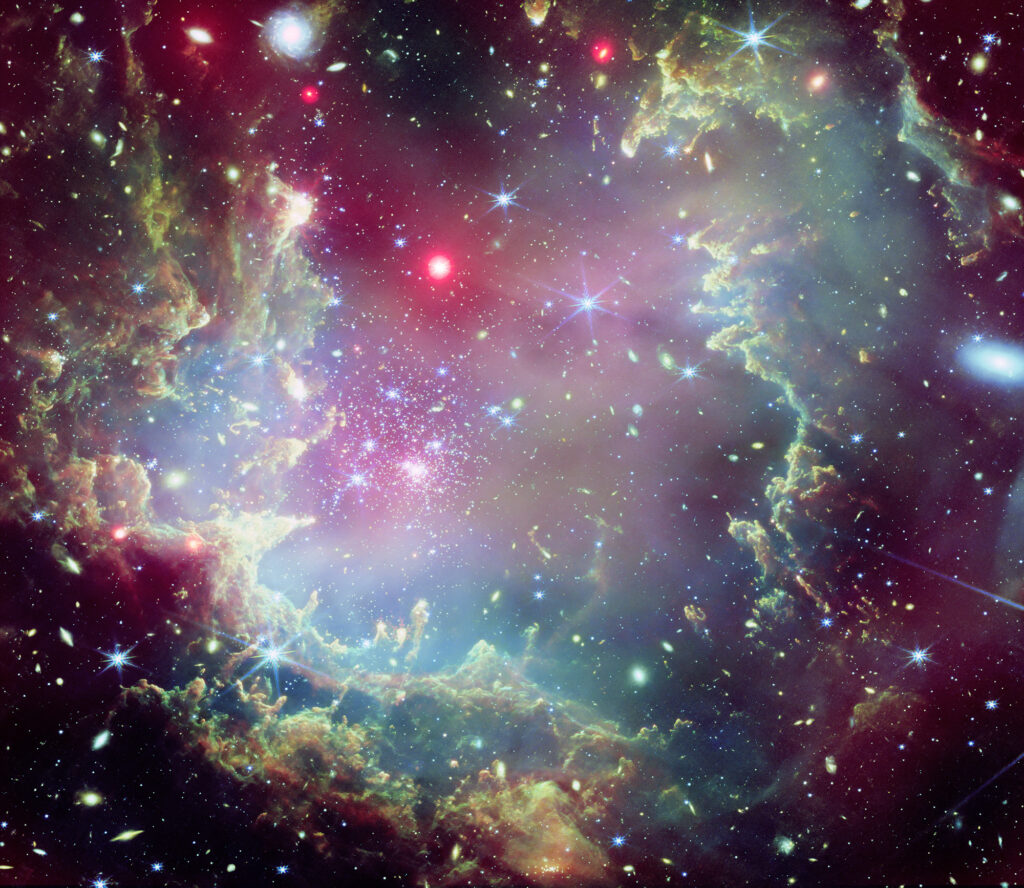[ad_1]
The colorful images of the cosmos and the brave humans that get to fully experience space all appear to have no shortage of holiday spirit. A few new images from powerful space telescopes, a special delivery to the International Space Station (ISS), and more are all part of a longer history of celebrating the season in space.
I’m dreaming of a white Christmas–on Mars

The Red Planet sometimes has some tinges of white. Images taken by the European Space Agency’s (ESA) High Resolution Stereo Camera on Mars Express show how swirls of carbon dioxide ice and dust layers can make the planet appear like it has a light dusting of snow. The images were taken in the Australe Scopuli region of Mars’ southern hemisphere
“The contrasting light and dark layers are particularly striking in the exposed faces of hills and valleys,” the ESA wrote in a press release. “They trace out the distinctive seasonal polar layered deposits characteristic of this region, formed as layers of ice freeze with varying amounts of dust trapped within.”
The mixture of smooth and steep slopes and tight bends almost makes the scene look like a Martian ski resort. Extremely warm clothing would be essential here, where temperatures are a brisk -193°F (-125°C).
Deck the halls with–a cosmic wreath

On December 18, NASA released a new image of star cluster NGC 602 and shows what looks like a festive wrath with twinkling lights. The image combines data from NASA’s Chandra X-ray Observatory with a previously released image taken by the James Webb Space Telescope (JWST). The JWST data provide the ring-like outline of the cosmic “wreath.” The X-rays from Chandra (in red) show young, massive stars illuminating the wreath and sending high-energy light into interstellar space.
NGC 602 is about 200,000 light-years from Earth. It lies on the outskirts of the Small Magellanic Cloud, one of the closest galaxies to the Milky Way.
Christmas in–space
NASA Astronauts Don Pettit and Sunita Williams and the crew aboard the ISS recently received some festive gear and holiday gifts courtesy of a SpaceX Dragon capsule.
Celebrating the holiday in space also has a long history. NASA’s Apollo 8 mission launched on December 21, 1968. A few days later, astronauts William Anders, Frank Borman, and James Lovell became the first humans to ever spend Christmas in space. They orbited the moon 10 times over 20 hours and sent a famous Christmas Eve broadcast that drew millions of listeners. At the end of the broadcast, Borman said, “And from the crew of Apollo 8, we close with good night, good luck, a Merry Christmas, and God bless all of you–all of you on the good Earth.”
[ Related: NASA’s Hubble space telescope reveals a galactic ‘string of pearls.’ ]
Rockin’ around the Christmas tree–galaxy

NGC 2264 is a cluster of young stars between one and five million years old. For reference, our sun is a middle-aged star about 1,000 times older.
In this new image of NGC 2264, Chandra data (red, purple, blue, and white) is combined with optical data (green and violet) captured by astrophotographer Michael Clow from his telescope in Arizona in November 2024.
Late last year, two of the most powerful space telescopes in the universe joined forces to highlight colorful galaxy clusters about 4.3 billion light-years away from Earth. Galaxy cluster MACS0416 shines in the image created by the Hubble Space Telescope and JWST that combines visible and infrared light.

MACS0416 is a pair of colliding galaxy clusters that will eventually combine to form an even bigger cluster. The different colors that look like festive, twinkling lights on a tree represent the varying wavelengths of light. The shortest are blue, the intermediate are green, and the longest are red.
“We’re calling MACS0416 the Christmas Tree Galaxy Cluster, both because it’s so colorful and because of these flickering lights we find within it,” astronomer Haojing Yan of the University of Missouri in Columbia said in a statement. “We can see transients everywhere.”
[ad_2]
Source link


